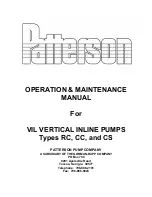
Cooling Oil -
Anytime the pump is
removed from operation, the cooling
oil in the motor ousing should be
h
checked visually for oil level and
contamination. To check oil, set unit
upright. Remove cap screws (6), lift
conduit box assembly (4) from motor
housing (3),
disconnect
Do Not
wiring from motor leads. With a
flashlight, visually inspect the oil in
the motor housing (3) to make sure it
is clean and clear, light amber in color
and free from suspended particles.
Milky white oil indicates the presence
of water. Oil level should be just
above the motor when pump is in
vertical position.
Seal Chamber -
Drain oil from seal
chamber by placing pump on its side
with pipe plug (18) downward and
remove pipe plug (18). If the oil is
found to contain c
onsiderable water
or other
contamination, the shaft seal
(19) should
be inspected and
replaced if required.
After leak is repaired, dispose of old
oil properly, and re ill with new oil.
f
Use soap solution around the sealed
areas above the oil level and nspect
i
joints for "air bubbles". If, after ive
f
minutes, the pressure is still holding
constant, and no "bubbles" /oil
seepage is observed, slowly bleed the
pressure and remove the gauge
assembly. Replace oil. Leek must be
located and repaired if pressure does
not hold.
Seal Chamber -
Check that seal
c
hamber is full of oil by removing
pipe plug (18). Apply pipe sealant to
p
ressure gauge assembly and tighten
into hole in bearing housing (1 ).
5
P
ressurize seal chamber to 20-25 PSI
and check for leaks.
Oil Replacement
- Set unit upright
and re ill with new cooling oil as per
f
table. Fill to just above motor as an air
space must remain in the top of the
housing
to
compensate for oil
expansion. Reassemble the o-ring (5)
and conduit box (4) to motor housing
(3). Apply thread locking compound
to cap screws (6) and place into holes
and torque to 15 ft/lbs.
Oil Replacement:
Seal Chamber -
Refill chamber
c
ompletely full with new cooling oil
or reuse the uncontaminated oil.
Figure 2
a) Inspect motor chamber for oil
level and contamination.
b) Inspect impeller and body for
excessive build-up or clogging.
c) Inspect motor, bearings and shaft
seal for wear or leakage.
NOTE: Item numbers in ( ) refer to
Figure 6.
4
Servicing
Ÿ
If oil is found to be clean and
uncontaminated
(measuring
above 15 V breakdown), re ill
k
f
the housing.
Ÿ
If oil is found to be dirty or
contaminated
(or
measures
below 15
breakdown), the
kV
pump
must
be
carefully
inspected for leaks at the shaft
seal, conduit box, o-rings, pipe
plug and pressure valve, before
re illing with oil. To locate the
f
leak, perform a pressure test.
Oil Testing
Ÿ
Drain oil into a clean, dry
container p
lacing pump on it’s
side, remove cap crews (6), lift
s
conduit box assembly (4) from
motor housing (3). In sepa ate
r
container drain seal chamber by
removing pipe plug (18).
Ÿ
Check oil for contamination
using an oil tester with a range to
30 kV breakdown.
Pressure builds up extremely
fast, increase pressure by
"TAPPING" air nozzle. Too
much pressure will damage
seal.
DO NOT exceed 10 PSI
in housing and 20-25 PSI in
seal chamber.
Pressure Test
Motor Housing -
Oil should be at
normal level. Remove pressure valve
(1 ) from motor housing (3). Apply
1
pipe sealant to pressure gauge
assembly and tighten into hole (See
Figure 2). Pressurize motor housing to
10 PSI.
DO
NOT
overfill
oil.
Overfilling of housing with oil
can create excessive and
dangerous hydraulic pressure
which can destroy the pump
and create a hazard.
Overfilling oil voids warranty.
06
Service
Cooling Oil
Recommended Supplier/Grade
BP
Enerpar SE100
Conoco
Pale Parafin 22
Mobile
D.T.E. Oil Light
Shell Canada
Transformer-10
Texaco
Diala-Oil-AX
barmesapumps.com
Summary of Contents for 6BSE12036LDS
Page 15: ......

































